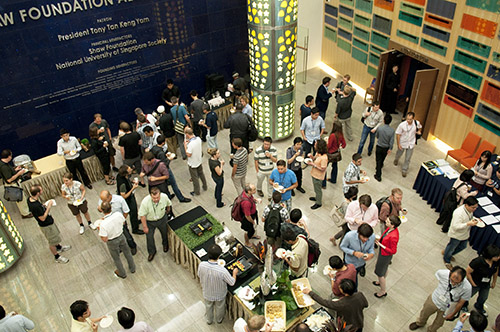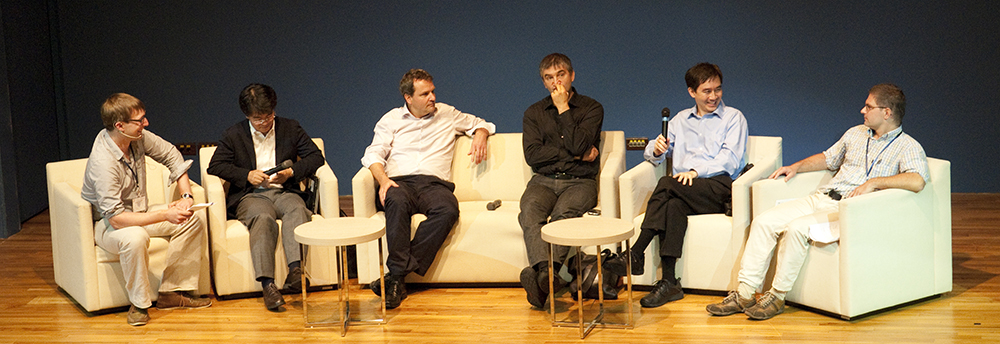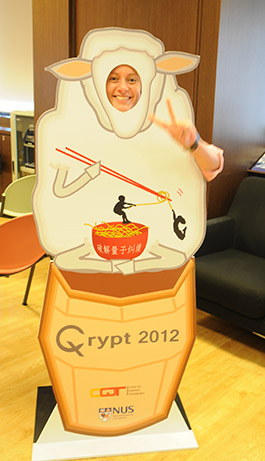Highlights
So long, QCRYPT

More than 160 researchers, students and industry representatives registered for QCRYPT 2012, held at the National University of Signapore.
| QCRYPT by numbers |
| 163 registered participants |
| (48 of them students) |
| 1 keynote presentation |
| 7 invited talks |
| 4 focus tutorials |
| 19 contributed talks |
| (29% acceptance ratio) |
| 66 posters |
Experts in quantum cryptography from around the world convened in Singapore for QCRYPT 2012, a conference on quantum cryptography held 10-14 September.
"It is great that QCRYPT, an annual conference first held last year, has already become a meeting point for everyone in quantum cryptography whether they work in experiment or theory," says Stephanie Wehner, the CQT Principal Investigator who led the local organising committee. Stephanie is one of the founders of the QCRYPT conference series. The meetings not only bring together experimental and theoretical researchers, but also those working towards commercialisation. It is the largest meeting on the topic.
Videos of the talks will be available online at QuTube, a portal for video related to quantum information. Find photos from the conference here.
Cryptography is often understood to be the art of encrypted communication, but in fact refers to all techniques that involve some form of secrecy. Attendees at QCRYPT heard the latest on extracting robust security from quantum behaviour for applications from communication to identify verification. For example, banks today often ask customers to verify their identity for online transactions by inputting a random number sent to a device the bank has previously given to the customer. Quantum physics offers various ways to generate random numbers and ensure their privacy beyond what is possible classically.
Indeed, cryptography applications are seen as one of the most promising areas for quantum technologies to be deployed in the real world. The meeting featured an industry session devoted to discussion of the real world challenges. The panel chair, Matthias Christandl from ETH Zurich, put the question like this: "why does the iPhone 5, which came out yesterday, not have quantum cryptography as one of its main communication devices?"
The panel of six speakers (pictured below) included the CEO of a company that has commercialised quantum key distribution systems, a representative from Singapore's DSO National Laboratories and an investor looking to fund quantum technology businesses.

Participants in the industry session at QCRYPT 2012, from left to right, were Matthias Christandl (ETH Zurich, panel chair), Akio Tajima (NEC), Gregoire Ribordy (ID Quantique), Serguei Beloussov (Runa Capital), Chan Shih Ping Richard (DSO, the Singapore national defence R&D organization) and Andreas Poppe (AIT, the Austrian Intitute of Technology). A report of the panel discussion appears on the National University of Singapore newshub.

The QCRYPT conferences have a sheep for a mascot. Why? Think the no-cloning theorem
One of the points made in the discussion is that it is hard to gauge how much commercial interest in quantum cryptography there really is, since customers purchasing security technology are unlikely to shout about it.
A lighter-hearted 'Rump Session' was held by the beach on Singapore's Sentosa island. With speakers limited to three minutes, treats included an introduction to the durian fruit by CQT's Valerio Scarani, presentation by Skype of new arXiv papers and an audio call with Stephen Wiesner, who founded the field of quantum information with his invention of 'quantum money'.
QCRYPT 2012 was organised by members of Stephanie's group and Admin Executive Evon Tan (responsibility: general magic). "Our team did an excellent job," said Stephanie.
The first QCRYPT meeting was held at ETH Zurich in Switzerland in 2011. QCRYPT 2013 will be held at the Institute for Quantum Computing at the University of Waterloo, Canada.






